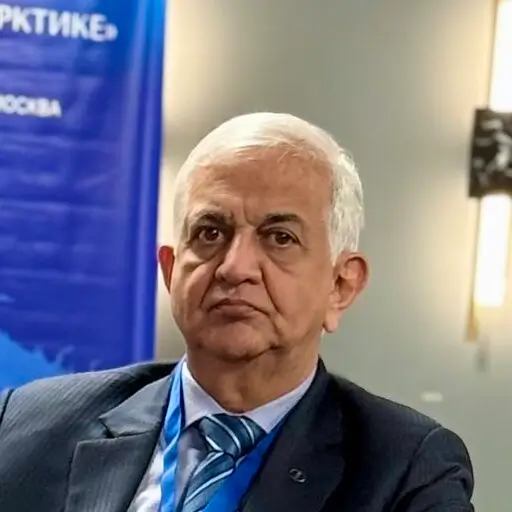
An in-depth analysis of the complex relationship between Russia and India in the Arctic, with Vice Admiral Pradeep Chauhan providing unique insights and perspectives on the development of transport and logistics using Arctic sea routes, in light of the U.S. and China’s policy in the region. Admiral’s speech at the International Expert Seminar, ‘The American Factor in Russia–India Relations in the Arctic’, 24 September 2025, Moscow. Source: Compiled by the author
In contemporary times, the Arctic has been an epicentre of big power geopolitical dynamics, including fresh accessions to NATO by countries comprising Russia’s eastern flank such as Finland (2023), and Sweden (2024), and the imposition of fresh sanctions on Russia as the Russo-Ukraine conflict drags on through its fourth year. These build upon the USA’s continuous expansion of the scope of sanctions imposed by Washington D.C., as also by the European Union, and are specifically focussed upon entities within Russia’s military industrial complex. Moreover, since 2022, the Arctic Council—originally a multilateral governance body—has been hampered due to Western countries’ suspension of cooperation in response to Russia’s actions in Ukraine.
The flipside of all this is that it has created a governance vacuum, providing space for bilateral and regional strategic initiatives outside Western-dominated frameworks.
India formulates a series of geostrategies, an illustrative sampling of which is depicted in Figure 1:
| Geostrategies for the attainment of geoeconomic goals | Geostrategies for the attainment of non-geoeconomic goals |
|---|---|
| Re-engineer and reform government-processes | Persistent advocacy of UNSC structural change |
| Priorise global economic engagement | Be (and be see to be) the first-responder in HADR, as also in the countering of illicit maritime activities |
| Lower Cost of Business through Deregulation | Be proactive in cooperative regional holistic security and stability constructs |
| Promote port-led development | Give tangible manifestation to India’s hierarchy of Strategic Partnerships |
| Develop and regionally promote high-quality infrastructure that is resilient against adverse impacts of climate change | Develop initiatives for physical-, digital-, and people-to-people (cultural) connectivity |
| Extensive Skilling in AI-ML | - |
Figure 1. Illustrative Geostrategies for the Attainment of its Geoeconomic- and Non-geoeconomic Goals. Source: Compiled by the author
In terms of India’s maritime geopolitics, the goals India seeks to attain within the maritime domain may be reduced to three principal ones:
- To protect its territorial integrity,
- To Grow its Economy, and
- To Establish and Maintain its Reputation as a Reliable and Preferred Maritime Partner.
With this typology having been internalised, it is now appropriate to turn to the prevailing geopolitical uncertainty across the Arctic and the High North.
The American And Chinese Factors In India-Russia Relations In The Arctic
Driven by the imperative of expanding its own activities in the Arctic, the Kremlin, too, is in the midst of a revaluation of its role within the Arctic Council and the formulation of a more confrontational strategic approach to the High North, thereby intensifying the already volatile situation in the Arctic.
There is no gainsaying the fact that Russia’s own Arctic strategy—like that of the USA and Europe—has pivoted away from scientific exploration towards asserting sovereignty, militarising Arctic territories, and accelerating (and expanding) resource-extraction. This pivot is driving significant urgency for the completion of military bases, the deployment of icebreakers (including nuclear-powered ones), and the development of an Arctic infrastructure network supporting oil, gas, and mineral extraction.
India’s Arctic policy, formalised in 2022 and expanded through scientific collaborations and infrastructure investments, seeks to advance Indian interests in six main areas:
- Scientific research;
- Capacity-building (and “capability-enhancement”);
- Governance and international cooperation;
- Transport and connectivity;
- Economic- and human development;
- Climate and environmental practices.
The Himadri research station at Ny-Ålesund and bilateral research-MoUs with Russia’s Arctic institutes exemplify India’s scientific interest. In addition, India’s energy security is felt to be closely tied to Arctic resource projects, including potential stakes in LNG developments such as Arctic LNG-2.
Amidst the prevailing geopolitical uncertainty of which mention has already been made, India, which has been the target of American ire in respect of its past purchases of Russian oil with the “penalties” meted out by Trump being in the form of punitive tariffs, seems determined to remain steadfast in the pursuit of its own national interests and, in this this context, New Delhi continues to prize as well as to prioritise its strategic autonomy, even though the country’s Arctic policy makes no mention of hard security. Indeed, India’s Arctic-engagement with Russia exemplifies New Delhi’s pursuit of strategic autonomy, whereby India seeks to maintain and advance its partnerships across competing blocs while advancing its national interests.
The positioning of India as a “stabilising factor” in Arctic affairs, by Russia’s Ambassador to India, His Excellency Mr Denis Alipov, emphasises India’s constructive approach in the Arctic. This positioning becomes particularly significant given China’s expanding Arctic presence through the “Polar Silk Road” initiative (even though its efficacy appears to be significantly reduced at the current point in time) and Beijing’s investments of some US 10 billion dollars in Russian Arctic infrastructure.
On the other hand, India’s interest in the development of Northern Sea Route (NSR) the cooperation with Russia on the serves several purposes—significant ones being securing energy supplies while preventing an excessive Russo-Chinese embrace. India seeks to deepen its footprint, balancing between Russia’s Arctic initiatives and its broader Indo-Pacific engagements, despite external pressures and regional complexities.
Against this backdrop, the succeeding paragraphs specifically seek to offer clarifications about the relevance to India of the NSR, as also Arctic integration in the Chennai-Vladivostok Maritime Corridor (CVMC).
What Should Be Done To Make The Arctic Corridors Economically Viable?
To begin with, much is often made of the shortened distance between Northern European and East Asian ports through the utilisation of the NSR. Yet, it is clearly unrealistic to take ‘distance’ as the sole criterion in determining the success of a maritime trade route. In any case, the NSR is shorter than the Southern Sea Route (SSR) only for ports located north of Shanghai. However, north of Shanghai, the seabed gradient is shallow and ports here are prone to heavy siltation. Thus, the business model for Greenfield ports intended to be built north of Shanghai must factor significant maintenance-dredging as a major and recurring cost, adversely impacting their profitability. This is quite different from the business model for ports south of Shanghai, where the coastal hydrology is rocky and deep with minimal requirement for dredging.
Likewise, while the distance per se may well be shorter, the ‘volume’ of goods that can be carried in a given single voyage of a given ship is a function of the ship’s size and design, both of which are heavily influenced by the average as well minimum depth available along the route in question. The situation in respect of the NSR is not at all encouraging. For instance, the depth of water available in the Dmitry Laptev and Sannikov Straits, south of the New Siberian Islands, is especially shallow—at 7 to 8 metres—and this unfavourable bathymetry imposes severe restrictions upon the amount or volume of cargo per ship, which can be transported through these straits. Shown below are “thumb rules” to demonstrate the correlation between the draught of a ship and the cargo carried (in DWT) as also the correlation between the length (overall) of a ship and the draught:

Source: Compiled by the author
What these thumb-rules demonstrate is that only very low volumes of cargo can be transported by a given ship sailing through the Dimitry Laptev Strait—or through the Sannikov Strait, for that matter, as although the situation in the Sannikov Strait is better than that in the Laptev Strait, it is still far from good! Consequently, economies of scale cannot be attained in the NSR.
Moreover, a maritime trade route is far more than just the loading- and destination ports. To make the route economically viable or profitable, shippers need to move cargo from and to multiple seaports along any given route. These ports need to be well connected to the hinterland by inland transport (e.g., rail and road or even inland waterways). This is what makes for a ‘shipping line’. Without these intermediate ports and the hinterland connectivity that they provide, a shipping route will not be profitable. There is a severe lack of infrastructure along the Northern Sea Route and to create trading entrepots in the Arctic hinterland that might then be connected to intermediate ports, thereby creating a shipping route, will be hugely capital-intensive and an extremely time-consuming process.
Finally, there is the question of the percentage of merchandise trade (imports and exports) that is accounted for by northern Europe. In the case of China, this is less than 3 percent and is unlikely to rise much higher, particularly given the EU’s hardening stance (including that of Germany, which is the only northern European country other than Russia that could benefit from the shorter NSR) vis-à-vis merchandise trade with China. Only time will tell if all this will change in a ‘post-Xi Jin Ping’ era. These basic considerations are not area-specific but are valid across geographies. Where multimodal movement of shipping cargo is concerned, factors of distance and time must be weighed against the volumes that can be transported as a function of economies of scale. Whenever cargo is shifted from one mode of transportation to another, significant delays inevitably accrue as a result of non-standardisation of hard infrastructure—railway gauges for instance—and of soft infrastructure, too, as well as a whole slew of non-tariff barriers.
Connections Between The Arctic And The Vladivostok-Chennai Maritime Corridor Are Almost Not Feasible
A frequently encountered (but nevertheless wholly misplaced) perception is that India’s Vladivostok-Chennai maritime corridor (VCMC) is directly linked to Arctic maritime routes or is part of Arctic cooperation. Such an assertion flies in the face of geography. Vladivostok is located at 43° 06’ North—a latitude that is well south of the Arctic Circle (~66° 33’ N). As such, Vladivostok is not an Arctic port. Goods reaching Vladivostok from Russia traverse the Trans-Siberian Railway (TSR) or the Baikal-Amur Mainline (BAM), over land, without any maritime involvement in the Arctic. It is, of course, true that this corridor reduces transit time (from over 40 days via traditional routes to approximately 24 days) and possibly costs (estimated be as much as 45 percent or so), thus having significant economic and strategic value. It is, of course, also true that the VCMC could potentially be very valuable for energy exports and strategic trade, especially when conventional routes face disruptions, such as in the case of Suez Canal blockages or regional tensions.
Additionally, the development of the VCMC aligns with Russia’s broader Asian pivot, and is linked to Moscow’s Far East infrastructure investments, and India’s embryonic “Act Far East” policy, fostering economic integration outside the Western sphere. For all that, however, the sea route from Vladivostok to Chennai does not traverse Arctic waters at all, but rather, passes through largely temperate maritime spaces such as the Bay of Bengal, the South China Sea, and the East China Sea. As such, Arctic shipping and resource projects remain geographically distinct and do not directly integrate into maritime routes to Vladivostok.
Conclusions
In sum, while the opportunities of Indo-Russian cooperation in the Arctic are many and uniformly exciting, the challenges of making the NSR an economically viable maritime proposition for India and Russia remain formidable.

Vice Admiral, AVSM & Bar, VSM (Retd), Director General
National Maritime Foundation

